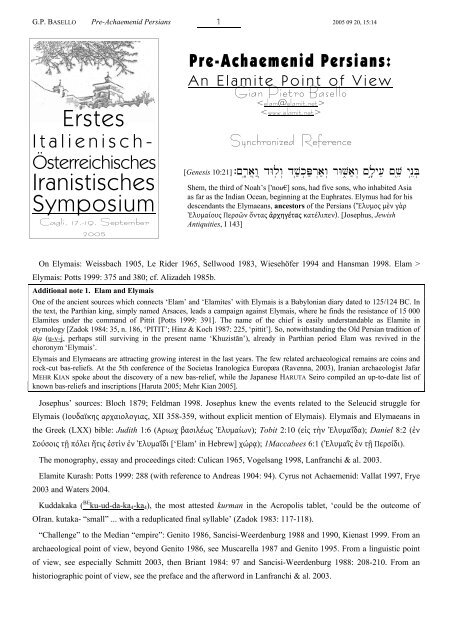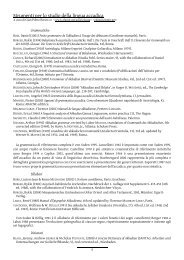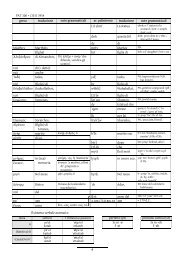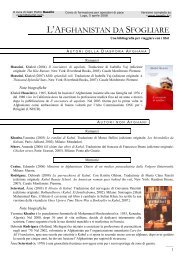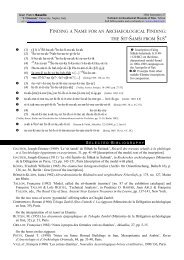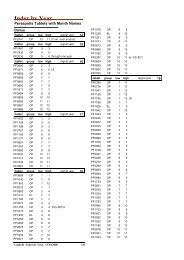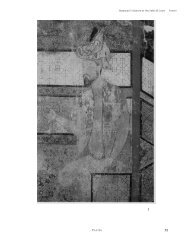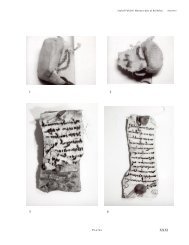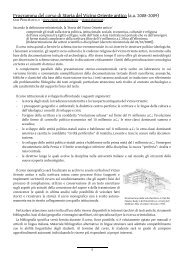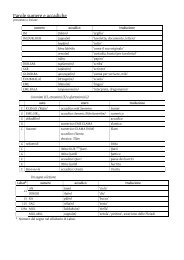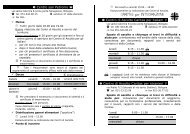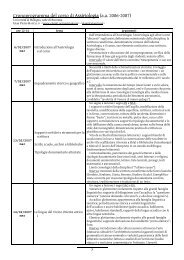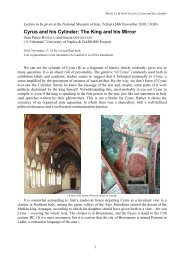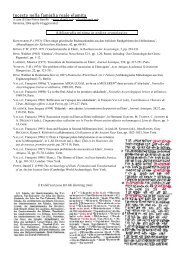Erstes Iranistisches Symposium - Elam.net
Erstes Iranistisches Symposium - Elam.net
Erstes Iranistisches Symposium - Elam.net
You also want an ePaper? Increase the reach of your titles
YUMPU automatically turns print PDFs into web optimized ePapers that Google loves.
G.P. BASELLO Pre-Achaemenid Persians 1<br />
2005 09 20, 15:14<br />
<strong>Erstes</strong><br />
Italienisch-<br />
Österreichisches<br />
<strong>Iranistisches</strong><br />
<strong>Symposium</strong><br />
Cagli, 17.-19. September<br />
2005<br />
Pre-Achaemenid Persians:<br />
An <strong>Elam</strong>ite Point of View<br />
Gian Pietro Basello<br />
<br />
<br />
Synchronized Reference<br />
[Genesis 10:21] `~r'(a]w:¥ dWlïw> dv;Þk.P;r>a;w> rWV+a;w> ~l'äy[e ~veÞ ynEïB.<br />
Shem, the third of Noah’s ['nou€] sons, had five sons, who inhabited Asia<br />
as far as the Indian Ocean, beginning at the Euphrates. Elymus had for his<br />
descendants the Elymaeans, ancestors of the Persians (Ἔλυμος μὲν γὰρ<br />
Ἐλυμαίους Περσῶν ὄντας ἀρχηγέτας κατέλιπεν). [Josephus, Jewish<br />
Antiquities, I 143]<br />
On Elymais: Weissbach 1905, Le Rider 1965, Sellwood 1983, Wiesehöfer 1994 and Hansman 1998. <strong>Elam</strong> ><br />
Elymais: Potts 1999: 375 and 380; cf. Alizadeh 1985b.<br />
Additional note 1. <strong>Elam</strong> and Elymais<br />
One of the ancient sources which connects ‘<strong>Elam</strong>’ and ‘<strong>Elam</strong>ites’ with Elymais is a Babylonian diary dated to 125/124 BC. In<br />
the text, the Parthian king, simply named Arsaces, leads a campaign against Elymais, where he finds the resistance of 15 000<br />
<strong>Elam</strong>ites under the command of Pittit [Potts 1999: 391]. The name of the chief is easily understandable as <strong>Elam</strong>ite in<br />
etymology [Zadok 1984: 35, n. 186, ‘PITIT’; Hinz & Koch 1987: 225, ‘pittit’]. So, notwithstanding the Old Persian tradition of<br />
ūja (u-v-j, perhaps still surviving in the present name ‘Khuzistān’), already in Parthian period <strong>Elam</strong> was revived in the<br />
choronym ‘Elymais’.<br />
Elymais and Elymaeans are attracting growing interest in the last years. The few related archaeological remains are coins and<br />
rock-cut bas-reliefs. At the 5th conference of the Societas Iranologica Europæa (Ravenna, 2003), Iranian archaeologist Jafar<br />
MEHR KIAN spoke about the discovery of a new bas-relief, while the Japanese HARUTA Seiro compiled an up-to-date list of<br />
known bas-reliefs and inscriptions [Haruta 2005; Mehr Kian 2005].<br />
Josephus’ sources: Bloch 1879; Feldman 1998. Josephus knew the events related to the Seleucid struggle for<br />
Elymais (Ιουδαϊκης αρχαιολογιας, XII 358-359, without explicit mention of Elymais). Elymais and Elymaeans in<br />
the Greek (LXX) bible: Judith 1:6 (Αριωχ βασιλέως Ἐλυμαίων); Tobit 2:10 (εἰς τὴν Ἐλυμαΐδα); Daniel 8:2 (ἐν<br />
Σούσοις τῇ πόλει ἥτις ἐστὶν ἐν Ἐλυμαΐδι [‘<strong>Elam</strong>’ in Hebrew] χώρᾳ); 1Maccabees 6:1 (Ἐλυμαῒς ἐν τῇ Περσίδι).<br />
The monography, essay and proceedings cited: Culican 1965, Vogelsang 1998, Lanfranchi & al. 2003.<br />
<strong>Elam</strong>ite Kurash: Potts 1999: 288 (with reference to Andreas 1904: 94). Cyrus not Achaemenid: Vallat 1997, Frye<br />
2003 and Waters 2004.<br />
Kuddakaka ( BE ku-ud-da-ka4-ka4), the most attested kurman in the Acropolis tablet, ‘could be the outcome of<br />
OIran. kutaka- “small” ... with a reduplicated final syllable’ (Zadok 1983: 117-118).<br />
“Challenge” to the Median “empire”: Genito 1986, Sancisi-Weerdenburg 1988 and 1990, Kienast 1999. From an<br />
archaeological point of view, beyond Genito 1986, see Muscarella 1987 and Genito 1995. From a linguistic point<br />
of view, see especially Schmitt 2003, then Briant 1984: 97 and Sancisi-Weerdenburg 1988: 208-210. From an<br />
historiographic point of view, see the preface and the afterword in Lanfranchi & al. 2003.
G.P. BASELLO Pre-Achaemenid Persians 2<br />
2005 09 20, 15:14<br />
KUR par-su-a, KUR par-su-aš, KUR par-su-maš: ‘An inscription by the Assyrian king Shalmaneser III, which was<br />
written around 843 B.C., mentions the region of Parsua’; ‘Somewhat later, at the end of the eighth century, the<br />
Assyrian text mention the country of Parsu(a)mash, which was situated somewhat east of the present-day city of<br />
Sulaimaniya; i.e., to the northeast of <strong>Elam</strong>’ (Dandamaev & Lukonin 1989: 3); Waters 1999: 100, footnote 7.<br />
KUR par-su-ma-aš in Weidner 1931-1932: 4.<br />
<strong>Elam</strong>ite administrative tablets from the Acropolis of Susa: 298 tablets, MDP 9, 1-87 and 89-298 (Scheil 1907,<br />
Jusifov 1963); MDP 11, 309 (Scheil 1911). MDP 9, 88 is a letter.<br />
Dating of the Acropolis tablets: 680 (Hinz 1987: 125-127) or 685 BC (Hinz & Koch 1987: 1327, ‘S’) according<br />
to HINZ; first quarter of the 6th century BC according to VALLAT (Vallat 1998a: 311); no earlier than the late 7th<br />
century BC according to STOLPER (Stolper 1984b: 8); ca. 650-550 according to DE MIROSCHEDJI (Miroschedji<br />
1982: 60ff), reign of Cyrus the Great and Cambyses according to CAMERON (Cameron 1948: 24, footnote 2). See<br />
also Steve 1986: 8, No. 2.<br />
Cyaxares in the Acropolis tablets: a Median anthroponym (Scheil 1907: 118; Cameron 1948: 24, footnote 2); the<br />
Median king Cyaxares (Hinz 1987: 126). MDP 9, 132:7: PAP BE ma-ak-iš-tur-ri du-iš; restored also in MDP 9,<br />
95:17: BE ma-a[k ...].<br />
Archaeological context of Acropolis tablets: found in 1900 by the French archaeologist Jacques DE MORGAN on<br />
the Acropolis of Susa, near the temple of Inšušinak built by will of Šutruk-Nahhunte II (717-699 BC) (Amiet 1967:<br />
27-29 and 1973: 4, footnote 1. See plan in Harper & al. 1992: 124, fig. 41)<br />
Biographical note on father SCHEIL: André-Salvini 1997.<br />
See Stolper 2004 for a brief introduction to <strong>Elam</strong>ite grammar.<br />
Additional note 2. The ‘Village perse-achéménide’<br />
The so-called ‘Village Perse-achéménide’, located on the western flanks of the ‘Ville des Artisans’, was considered proof of<br />
the existence of a Persian community settled in the neighbourhood of Susa already in the 8th century BC. To support this<br />
thesis, Ghirshman put forward a number of links between the oldest layers of the ‘Village Perse-achéménide’ I and Iron II sites<br />
comparatively late like Sialk VI and Giyan I (Ghirshman 1954, especially pp. 71-74). Stronach showed that the ‘Village’<br />
cannot be so ancient: it should be dated to the 6th century BC, preceded by an <strong>Elam</strong>ite occupation starting from ca. 625 BC<br />
(Stronach 1974: 244; also Steve 1986: 9 and Miroschedji 1981a: 38-39). According to Boucharlat, the only traces of an<br />
Achemenid occupation went back to the end of the Achemenid period, as showed by subsequent soundings (Boucharlat 1990:<br />
154; see also Dandamaev 1989: 2-3).<br />
Persians in the Acropolis tablets: Henkelman 2003a: 211-213; Persian: Waters 1999: 105-106.<br />
Iranian names in the Acropolis tablets: Scheil 1907, passim; Mayrhofer 1971; Hinz 1975; Zadok 1984a; Hinz &<br />
Koch 1987. Hinz 1987: 128: 65 anthroponym, 10% of the attested onomastics.<br />
Synopsis of the occurrences of parsa as collective designation:<br />
P type: MDP 9, 11 (Zampegir), 49 (Huri), 51 (Datiyana), 94 (Zampegir), 187 (Datiyana), 246 (Datiyana?), 281:20,<br />
281:29 (Datiyana);<br />
S type: MDP 9, 121;<br />
O type: MDP 9, 166:4, 166:25;<br />
fragmentary: MDP 9, 185, 233, 272 (S type?);<br />
[proper name: MDP 9, 47 (or S0 type?), 97 (or O type?), 117 (or S0 type?).]<br />
Unsak, second most attested collective designation (14 occurrences): Vallat 1992b.<br />
Additional note 3. Products related to the occurrences of Persian people<br />
Among the products related to the occurrences of Persian people, one can find kuktu, ‘overalls’, BABBAR.BABBAR ‘white’<br />
and dabantina ‘blue’, tukli tain ‘light-grey (i.e. made in wool [Hinz & Koch 1987: 268, s.v. ‘ta-in’]) clothing’, likkina another<br />
clothing, ri-tú.hu-el-ip perhaps a ‘skirt’, and weapons such as šukurrum ‘spears’, BAN ‘bows’ and sa-ah GI ‘arrow-heads’. The<br />
translations follows the (somewhat hypothetical) proposals by Hinz and Koch (1987; see also Hinz 1967).
G.P. BASELLO Pre-Achaemenid Persians 3<br />
2005 09 20, 15:14<br />
<strong>Elam</strong>ite administrative tablets from Tall-e Malyān (ca. 1000 BC): published in Stolper 1984b.<br />
On nomadic component in neo-<strong>Elam</strong>ite period: Miroschedji 1990: 62.<br />
Fig. 1: Model of demographic development in south-western Iran from 5th to 1st millennium BC (after<br />
Miroschedji 1990: 63, fig. 4). Curve No. 1: global population, including nomadic groups; curve No. 2 (thick):<br />
sedentary popolation in Susiana; curve No. 3 (dashed): sedentary population in the Marv Dasht plan.<br />
Collective designations based on an anthroponym as references to the eponym of a nomadic group: Vallat 1992b.<br />
Acropolis tablets: BE parsa; Persepolis tablets: AŠ pá-ir-sa15 ‘Persepolis’.<br />
Babylonian name Appalaya: Hinz & Koch 1987: 20, s.v. ‘hh.ab-ba-la-a’; Stolper 1984c: 305, nota 20. On<br />
Aramaean groups: Malbran-Labat 1980 and 1981; also Stolper 1986: 239 and Henkelman 2003b: col. 257.<br />
Appalaya is qualified as ‘king’ in MDP 9, 71.<br />
“Tribes” responsible for the impression of fragmentation of power in neo-<strong>Elam</strong>ite period: Henkelman 2003b:<br />
cols. 257-259. Cf. the insight in Scheil 1907: p. IV: ‘Il ne s’agit donc pas de villes ou provinces étrangères qui<br />
auraient été tributaires de la cour de Suse, mais de simples particuliers ou de groupes d’individus qui, comme<br />
négociants et industriels, avaient colonisé en pays élamite’.<br />
On Kalmākarra hoard and the reign of Samati: Vallat 1996c; Henkelman 2003a: 214-27 and 2003b: col. 257.<br />
“Regulated hostility” and “gift exchange” between late Achaemenid kings and Uxioi and Cossean tribes: Briant<br />
1996: 747-753, especially p. 752.<br />
Additional note 4. Collective designations in the Persepolis tablets<br />
In the Persepolis tablets, the number of collective designations did not increase, but single designations changed: Persians are<br />
no longer mentioned explicitly (neither <strong>Elam</strong>ites are), and, instead of unknown* peoples, we find Egyptians and Indians<br />
(Giovinazzo 1987b e 2001), from end to end of the Persian-centric world. The most substantial difference is the function<br />
assumed by groups of people: not receivers of goods or clothings as in Susa, but team of workers (kurtaš), foreigner settled in<br />
the heart of Persis (Uchitel 1991), not involved in at par exchanges but in services demanded as immigrants or convicts<br />
(Dandamaev 1975a; Koch 1983), whose knowledge we have because of the food rations they received.<br />
* Although it should be mentioned [ BE ]EŠŠANA AŠ mi-is-ri-[pè]-na ‘king of Egyptians(?)’ in MDP 9, 158: r5-6.<br />
Please note that in the handout ‘...’ marks omitted text (for sake of conciseness) while ‘[...]’ marks missing (i.e.<br />
damagaed) text.<br />
Acknowledgements<br />
I wish to thank prof. Grazia GIOVINAZZO (‘L’Orientale’ University, Naples) and prof. François VALLAT for the attention given<br />
to this work and the preciuos suggestions. Thanks to Velizar Sadovski (Institute for Iranian Studies, Austrian Academy of<br />
Sciences) for reporting the misprints in the handout.
G.P. BASELLO Pre-Achaemenid Persians 4<br />
2005 09 20, 15:14<br />
Selected bibliography<br />
ALIZADEH, Abbas (1985b) ‘Elymaean occupation of Lower Khuzestan during the Seleucid and Parthian periods: a proposal’,<br />
Iranica Antiqua, 20, pp. 175-195, Leiden.<br />
ANDREAS, F.C. (1904) ‘Über einige Fragen der ältesten persischen Geschichte’, Verhandlungen des XIII. internationalen<br />
Orientalisten-Kongresses, Hamburg September 1902, pp. 93-97, Leiden: Brill.<br />
AMIET, Pierre (1967) ‘Éléments émaillées du décor architectural néo-élamite’, Syria, 44, pp. 27-46, Paris.<br />
AMIET, Pierre (1973) ‘La glyptique de la fin de l’<strong>Elam</strong>’, Arts Asiatiques, 28, pp. 3-32 e tavole 1-11, Paris.<br />
ANDRÉ-SALVINI, Béatrice (1997) ‘«Ici commence l’histoire de l’<strong>Elam</strong>», L’œuvre du père Jean-Vincent Scheil’, in Nicole<br />
CHEVALIER, ed., Une mission en Perse 1897-1912 (Les dossiers du musée du Louvre), pp. 110-125, Paris.<br />
BLOCH, H. (1879) Die Quellen des Flavius Josephus in siener Archäologie, Leipzig: B.G. Teubner (reprint Schaan,<br />
Liechtenstein: Sändig, 1983).<br />
BOUCHARLAT, Rémy (1990) ‘Suse et la Susiane a l’époque achéménide données archéologiques’, in Heleen SANCISI-<br />
WEERDENBURG & Amélie KUHRT, eds., Centre and Periphery. Proceedings of the Groningen 1986 Achaemenid History<br />
Workshop (Achaemenid History, 4), pp. 149-175, Leiden.<br />
BRIANT, Pierre (1982) État et Pasteurs au Moyen-Orient ancien, Paris / Cambridge.<br />
BRIANT, Pierre (1984) ‘La Perse avant l’empire (un état de la question)’, Iranica Antiqua, 19, pp. 71-118, Leiden.<br />
BRIANT, Pierre (1996) Histoire de l’empire perse de Cyrus à Alexandre, Paris (published in the same year as part of the series<br />
Achaemenid History, 10, Leiden).<br />
CULICAN, William (1965) The Medes and Persians, New York / Washington.<br />
DANDAMAEV, M.A. (1975a) ‘Forced Labour in the Palace Economy in Achaemenid Iran’, Altorientalische Forschungen, 2, pp.<br />
71-78, Berlin.<br />
DANDAMAEV, M.A. (1989) A Political History of the Achaemenid Empire, translated from Russian by Willem J. VOGELSANG,<br />
Leiden.<br />
DANDAMAEV, Muhammad A. & Vladimir Grigor'evič LUKONIN (1989) The Culture and Social Institutions of Ancient Iran,<br />
translated from Russian by Philip L. KOHL, Cambridge.<br />
FELDMAN, Louis H. & G. HATA, eds. (1987) Josephus, Judaism, and Christianity. Detroit: Wayne State University Press.<br />
FELDMAN, Louis H. (1989) Josephus, the Bible, and History. Detroit: Wayne State University Press.<br />
FELDMAN, Louis H. (1998) Josephus’s Interpretation of the Bible (Hellenistic Culture and Society, 27), Berkeley / Los<br />
Angeles / London: University of California Press.<br />
FELDMAN, Louis H., ed. (1999) Judean Antiquities Books 1–4 (Flavius Josephus: Translation and Commentary, 3), Leiden:<br />
Brill.<br />
FELDMAN, Louis H. (1999-2000) ‘Rearrangement of Pentateuchal Narrative Material in Josephus’ Anitquities, Books 1-4’,<br />
Hebrew Union College Annual, 70-71, pp. 129-151.<br />
FRYE, Richard N. (2003) ‘Cyrus was no Achaemenid’, in Carlo G. CERETI, Mauro MAGGI & Elio PROVASI, eds., Religious<br />
themes and texts of pre-Islamic Iran and Central Asia (Beiträge zur Iranistik, 24), pp. 111-114, Wiesbaden.<br />
GENITO, Bruno (1986) ‘The Medes. A Reassessment of the Archaeological Evidence’, East and West, 36/1-3, pp. 11-81,<br />
Rome.<br />
GENITO, Bruno (1995) ‘The Material Culture of the Medes: Limits and Perspectives in the Archaeological Research’, in Pier<br />
Giovanni DONINI, Claudio LO JACONO & Luigi SANTA MARIA, eds., Un ricordo che non si spegne. Scritti di docenti e<br />
collaboratori dell’Istituto Universitario Orientale di Napoli in memoria di Alessandro Bausani, pp. 103-118, Napoli.<br />
GHIRSHMAN, Roman (1954) Village perse-achéménide (Mémoires de la Délégation en Perse, 36), avec la collaboration de A.<br />
GHIRSHMAN, G. HAENY, A. JULLIEN, H. PAPER, M. RUTTEN, R. VAUFREY, Paris.<br />
GIOVINAZZO, Grazia (1987b) ‘Bakabadda, un Egyptien à Persépolis’, Nouvelles Assyriologiques brèves et utilitaires,<br />
1987/110, Paris.<br />
GIOVINAZZO, Grazia (1993) ‘Les šaumarraš dans les textes de Persépolis’, Annali dell’Istituto Universitario Orientale, 53, pp.<br />
121-127, Napoli.<br />
GIOVINAZZO, Grazia (1995) ‘I 'puhu' nei testi di Persepoli. Nuove interpretazioni’, Annali dell’Istituto Universitario Orientale,<br />
55, pp. 141-157, Napoli.<br />
GIOVINAZZO, Grazia (2000-2001) ‘Les Indiens à Suse’, Annali dell’Istituto Universitario Orientale, 60-61, pp. 59-76, Napoli.<br />
HANSMAN, John (1992) ‘Characene and Charax’, in Encyclopædia Iranica, 5, pp. 363-365, Costa Mesa.<br />
HANSMAN, John (1998) ‘Elymais’, in Encyclopædia Iranica, 8, pp. 373-376, Costa Mesa.<br />
HARPER, Prudence O., Joan ARUZ & Françoise TALLON, eds. (1992) The Royal City of Susa. Ancient Near Eastern Treasures<br />
in the Louvre, pp. 253-260, New York.
G.P. BASELLO Pre-Achaemenid Persians 5<br />
2005 09 20, 15:14<br />
HARUTA Seiro (2005) ‘Elymaean and Parthian Inscriptions from Khuzestan: A Survey’, in Antonio PANAINO & Andrea PIRAS,<br />
eds., Proceedings of the 5th Conference of the Societas Iranologica Europæa, 1, forthcoming.<br />
HENKELMAN, Wouter (2003a) ‘Persians, Medes and <strong>Elam</strong>ites. Acculturation in the Neo-<strong>Elam</strong>ite Period’, in Giovanni B.<br />
LANFRANCHI, Michael ROAF & Robert ROLLINGER, eds., Continuity of Empire (?): Assyria, Media, Persia (History of the<br />
Ancient Near East. Monographs, 5), pp. 181-231, Padova: S.a.r.g.o.n.<br />
HENKELMAN, Wouter (2003b) ‘Defining Neo-<strong>Elam</strong>ite History’, Bibliotheca Orientalis, 60/3-4, colonne 251-263, Leiden<br />
(available on the Inter<strong>net</strong> at the address with sub-title ‘Some thoughts on M.W. Waters, A Survey of<br />
Neo-<strong>Elam</strong>ite History’).<br />
HINZ, Walther (1967) ‘Zu den Zeughaustäfelchen aus Susa’, in Festschrift für Wilhelm Eilers. Ein Dokument der<br />
internationalen Forschung zum 27. September 1966, pp. 85-98, Wiesbaden.<br />
HINZ, Walther (1987) ‘<strong>Elam</strong>s Übergang ins Perserreich’, in Transition Periods in Iranian History. Actes du symposium de<br />
Fribourg-en-Brisgau (22-24 mai 1985), pp. 125-134, Leuven.<br />
HINZ, Walther & Heidemarie KOCH (1987) <strong>Elam</strong>isches Wörterbuch (in 2 Teilen) (Archäologische Mitteilungen aus Iran,<br />
Ergänzungsband 17), Berlin.<br />
JUSIFOV, Ju.B. (1958b) ‘Carskoe remeslennoe chozjajstvo v Ėlame midijsko-persidskogo vremeni’, Trudy Instituta Istorii AN<br />
Azerbajdžanskoj SSR, 13, pp. 80-106 (in Russian).<br />
JUSIFOV, Ju.B. (1963) ‘Ėlamskie chozjajstvennye dokumenty iz Suz’ (‘Documenti economici elamici da Susa’), Vestnik<br />
Drevnej Istorii, 84/2, pp. 189-222 and 85/3, pp. 199-261, Moskva (in Russian).<br />
KIENAST, Burkhart (1999) ‘The So-Called 'Median Empire'’, Bullettin of the Canadian Society for Mesopotamian Studies, 34,<br />
pp. 59-67.<br />
KOCH, Heidemarie (1983) ‘Zu den Lohnverhältnissen der Dareioszeit in Persien’, in Heidemarie KOCH & D.N. MACKENZIE,<br />
eds., Kunst, Kultur und Geschichte der Achämenidenzeit und ihr Fortleben (Archäologische Mitteilungen aus Iran,<br />
Ergänzungsband 10), pp. 19-50, Berlin.<br />
LAMBERT, Maurice (1977) ‘Deux textes élamites de la fin du septième siècle’, Journal Asiatique, 265/3-4, pp. 221-225, Paris.<br />
LANFRANCHI, Giovanni B., Michael ROAF & Robert ROLLINGER, eds. (2003) Continuity of Empire (?): Assyria, Media, Persia<br />
(History of the Ancient Near East. Monographs, 5), Padova: S.a.r.g.o.n.<br />
LE RIDER, Georges (1965) Suse sous les Séleucides et les Parthes. Les trouvailles monétaires et l’histoire de la ville<br />
(Mémoires de la Délégation en Perse, 38), Paris.<br />
MALBRAN-LABAT, Florence (1980) ‘Eléments pour une recherche sur le nomadisme en Mésopotamie au premier millénaire<br />
avant J.-C.’, Journal Asiatique, 268, pp. 11-33, Paris.<br />
MALBRAN-LABAT, Florence (1981) ‘Les tribus pastorales du sud-mésopotamien au début du 1 er millénaire avant J.-C.’,<br />
Production pastorale et société, 8, pp. 25-34, Paris.<br />
MARAS, S. (2005) ‘Notes on Seals and Seal Use in Western Iran from c. 900-600 BCE’, Iranica Antiqua, 40, pp. 133-148.<br />
MAYRHOFER, Manfred (1971) Aus der Namenwelt Alt-Irans. Die zentrale Rolle der Namenforschung in der Linguistik des Alt-<br />
Iranischen (Innsbrucker Beriträge zur Sprachwissenschaft, Vorträge 3), Innsbruck (reprinted in Ausgewählte Kleine<br />
Schriften, pp. 127-141, Wiesbaden 1979).<br />
MAYRHOFER, Manfred (1973) Onomastica Persepolitana. Das altiranische Namengut der Persepolis-Täfelchen, with the<br />
collaboration of J. HARMATTA, Walther HINZ, Rüdiger SCHMITT & Jutta SEIFERT, Wien.<br />
MEHR KIAN, Jafar (2005) ‘Tisiyun Elymaean Relief of Mehrnān, Izeh/Malmir, Susan Plan (Xuzestan)’, in Antonio PANAINO &<br />
Andrea PIRAS, eds., Proceedings of the 5th Conference of the Societas Iranologica Europæa, 1, forthcoming.<br />
MIROSCHEDJI, Pierre de (1985) ‘La fin du royaume d’Anšan et de Suse et la naissance de l’Empire perse’, Zeitschrift für<br />
Assyriologie und vorderasiatische Archäologie, 75, pp. 266-306, Berlin / Leipzig.<br />
MIROSCHEDJI, Pierre de (1990) ‘La fin de l’<strong>Elam</strong>: essai d’analyse et d’interprétation’, Iranica Antiqua, 25, pp. 47-95, Leiden /<br />
Gent.<br />
MIROSCHEDJI, Pierre de (1982) ‘Notes sur la glyptique de la fin de l’Élam’, Revue d’Assyriologie et d’Archéologie Orientale,<br />
76, pp. 51-63, Paris.<br />
POTTS, Daniel T. (1999) The Archaeology of <strong>Elam</strong>. Formation and Transformation of an Ancient Iranian State (Cambridge<br />
World Archaeology), New York (reviewed in Koch 2001b).<br />
SANCISI-WEERDENBURG, Heleen (1988) ‘Was there ever a Median Empire?’, in Amélie KUHRT & Heleen SANCISI-<br />
WEERDENBURG, eds., Method and Theory. Proceedings of the London 1985 Achaemenid History Workshop (Achaemenid<br />
History, 3), pp. 197-212, Leiden.<br />
SANCISI-WEERDENBURG, Heleen (1990) ‘The Quest for an Elusive Empire’, in idem & Amélie KUHRT, eds., Centre and<br />
Periphery. Proceedings of the Groningen 1986 Achaemenid History Workshop (Achaemenid History, 4), pp. 263-274,<br />
Leiden.<br />
SCHEIL, Vincent (1907) Textes élamites-anzanites, troisième série (Mémoires de la Délégation en Perse, 9), Paris.<br />
SCHEIL, Vincent (1911) Textes élamites-anzanites, quatrième série (Mémoires de la Délégation en Perse, 11), Paris.
G.P. BASELLO Pre-Achaemenid Persians 6<br />
2005 09 20, 15:14<br />
SCHMITT, Rüdiger (2003) ‘Die Sprache der Meder – eine grosse Unbekannte’, in Giovanni B. LANFRANCHI, Michael ROAF &<br />
Robert ROLLINGER, eds., Continuity of Empire (?): Assyria, Media, Persia (History of the Ancient Near East. Monographs,<br />
5), pp. 23-36, Padova: S.a.r.g.o.n.<br />
SELLWOOD, David (1983) ‘Minor states in southern Iran’, in The Cambridge History of Iran, 3/1, pp. 299-321, Cambridge.<br />
STEVE, Marie-Joseph (1986) ‘La fin de l’Élam: à propos d’une empreinte de sceau-cylindre’, Studia Iranica, 15, pp. 7-21 e<br />
tavola 1, Paris.<br />
STEVE, Marie-Joseph (1988c) ‘Le déterminatif masculin BE en néo-élamite et élamite-achéménide’, Nouvelles Assyriologiques<br />
brèves et utilitaires, 1988/35, pp. 23-24, Paris.<br />
STEVE, Marie-Joseph (1992) Syllabaire <strong>Elam</strong>ite. Histoire et Paleographie (Civilisations du Proche-Orient: Serie II, Philologie<br />
1), Neuchâtel / Paris.<br />
STOLPER, Matthew W. (1984b) Texts from Tall-i Malyan I. <strong>Elam</strong>ite Administrative Texts (1972-1974) (Occasional Publications<br />
of the Babylonian Fund, 6), Philadelphia.<br />
STOLPER, Matthew W. (1984c) ‘The Neo-Babylonian Text from the Persepolis Fortification’, Journal of Near Eastern Studies,<br />
43, pp. 299-310, Chicago.<br />
STOLPER, Matthew W. (1986) ‘A Neo-Babylonian Text from the Reign of Ḫallušu’, in Léon de MEYER, Hermann GASCHE &<br />
François VALLAT, eds., Fragmenta Historiae <strong>Elam</strong>icae. Mélanges offerts à M.-J. Steve, pp. 235-241, Paris.<br />
STOLPER, Matthew W. (2004) ‘<strong>Elam</strong>ite’, in Roger D. WOODARD, ed., The Cambridge encyclopedia of the world’s ancient<br />
languages, pp. 60-94, Cambridge: Cambridge University Press.<br />
STRONACH, David (1974) ‘Achaemenid Village I at Susa and the Persian Migration to Fars’, Iraq, 36, pp. 239-248 and plates<br />
49-55, London.<br />
THACKERAY, Henry St. John (1927) Josephus (The Loeb Classical Library), 4 (reprinted in 1961).<br />
UCHITEL, A. (1991) ‘Foreign Workers in the Fortification Archive’, in Mésopotamie et <strong>Elam</strong>: actes de la XXXVIème Rencontre<br />
assyriologique internationale, Gand, 10-14 juillet 1989, pp. 127-135, Ghent.<br />
VALLAT, François (1987g) ‘Perse, Persépolis dans les textes achéménides rédigés en élamite’, Nouvelles Assyriologiques<br />
brèves et utilitaires, 1987/113, Paris.<br />
VALLAT, François (1992b) ‘Les prétendus fonctionnaires unsak des textes néo-élamites et achéménides’, DATA: Achaemenid<br />
History Newsletter, 1/4, p. 5, Utrecht (see the update at , 2002, September 30).<br />
VALLAT, François (1993) Les noms géographiques des sources suso-élamites (Répertoire Géographique des Textes<br />
Cunéiformes, 11), Wiesbaden.<br />
VALLAT, François (1995b) ‘Une inscription élamite écrite de droite à gauche!’, Nouvelles Assyriologiques brèves et utilitaires,<br />
1995/45, pp. 38-39, Paris.<br />
VALLAT, François (1996c) ‘Le royaume élamite de SAMATI’, Nouvelles Assyriologiques brèves et utilitaires, 1996/31, pp. 21-<br />
22, Paris.<br />
VALLAT, François (1997) ‘Cyrus l’usurpateur’, Topoi. Orient-Occident. Supplément, 1, pp. 423-434.<br />
VALLAT, François (1998a) ‘<strong>Elam</strong>, i. The History of <strong>Elam</strong>’, in Encyclopædia Iranica, 8, pp. 301-313, London / New York<br />
(published in 1997 according to Stolper 2004).<br />
VALLAT, François (2005) ‘L’inscription néo-élamite de manaka[...]-untaš et l’emploi des déterminatifs à basse époque’, in<br />
Michele BERNARDINI & Natalia TORNESELLO, Festschrift Giovanni D’Erme, forthcoming.<br />
VOGELSANG, Willem J. (1998) ‘Medes, Scythians and Persians: the Rise of Darius in a North-South Perspective’, Iranica<br />
Antiqua, 33, pp. 195-224, Leiden.<br />
WATERS, Matthew W. (1996) ‘Darius and the Achaemenid Line’, The Ancient History Bulletin, pp. 11-18, Chicago / Calgary.<br />
WATERS, Matthew W. (1999) ‘The Earliest Persians in Southwestern Iran: The Textual Evidence’, Iranian Studies, 32, pp. 99-<br />
107, Cambridge, Massachusetts.<br />
WATERS, Matthew W. (2000) A Survey of Neo-<strong>Elam</strong>ite History (State Archives of Assyria Studies, 12), Helsinki.<br />
WATERS, Matthew W. (2004) ‘Cyrus and the Achaemenids’, Iran, 42, pp. 91-102, London.<br />
WEIDNER, Ernst F. (1931-1932) ‘Die älteste Nachricht über das persische Königshaus. Kyros I. ein Zeitgenosse<br />
Aššurbânaplis’, Archiv für Orientforschung, 7, pp. 1-7, Berlin / Graz / Osnabrück.<br />
WEISSBACH, Franz Heinrich (1905) ‘Elymais’, in Paulys Realencyclopädie der classischen Altertumswissenschaft, 5/2, coll.<br />
2458-2467, Stuttgart.<br />
WIESEHÖFER, Josef (1994) Die ‘dunklen Jahrunderte’ der Persis: Untersuchungen zu Geschichte und Kultur von Fāers in<br />
frühhellenistischer Zeit (330-140 v.Chr.) (Zetemata, 90), Munich.<br />
ZADOK, Ran (1983) ‘A Tentative Structural Analysis of <strong>Elam</strong>ite Hypocoristica’, Beiträge zur Namenforschung, neue Folge 18,<br />
pp. 93-120, Heidelberg.<br />
ZADOK, Ran (1984) The <strong>Elam</strong>ite Onomasticon (Supplemento agli Annali dell’Istituto Universitario Orientale, 40), Napoli.
G.P. BASELLO Pre-Achaemenid Persians 7<br />
2005 09 20, 15:14<br />
ZADOK, Ran (1984a) ‘On Some Non-Semitic Names in the Ancient Near East’, Beiträge zur Namenforschung, neue Folge 19,<br />
pp. 385-389, Heidelberg.
G.P. BASELLO Pre-Achaemenid Persians 8<br />
2005 09 20, 15:14<br />
Abstract<br />
References to Persians before the Achaemenid period are known not only from Mesopotamian sources: as<br />
gentilic designation, ‘Persian’ occurs at least 11 times both in singular and plural form (<strong>Elam</strong>ite pár-sir-(ra) and<br />
pár-sìp) in the neo-<strong>Elam</strong>ite administrative tablets from the Acropolis of Susa (V. SCHEIL, MDP 9). In 6<br />
occurrences, the plural form is in concord with people named after a locale; in another occurrence the singular form<br />
singles out an individual; in 2 occurrences it seems to mark items as of Persian kind. Often some proper names are<br />
related to these occurrences, and most of them are clearly Iranian. According to R. ZADOK (Beiträge zur<br />
Namenforschung, n.F. 18 (1983)), even the name of the most prominent superintendent (designated as kurman) of<br />
the administration, Kuddakaka, might be Iranian. However, the most striking insight is not the presence of Persian<br />
people in neo-<strong>Elam</strong>ite sources, but the evidence for their relationships with the administrative apparatus both as<br />
individuals and as a group. Unfortunately, the dating of the tablets is much debated (W. HINZ: 685 BC; F. VALLAT:<br />
first quarter of the 6th century BC; G.G. CAMERON: coeval to Cyrus the Great and Cambyses) and the exact<br />
meaning of the technical language of administration is still unclear.


